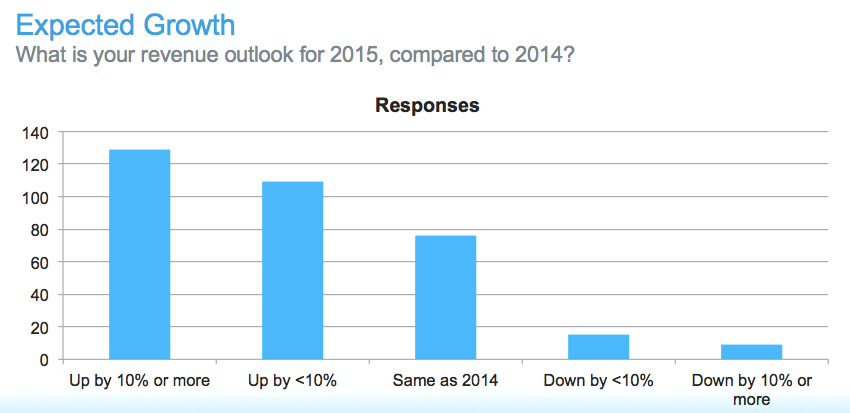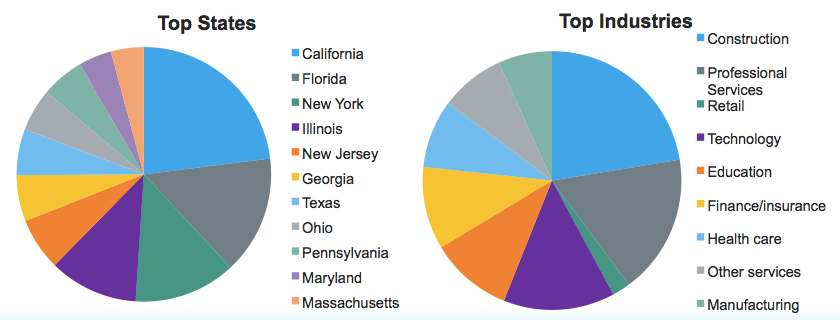
Get your FREE 30-day trial.
Please complete all fields.
If you’ve ever led or worked for a startup or small business, you probably won’t be surprised to learn that most small-business principals expect their companies to grow this year.
This may seem obvious; you don’t exactly start a business expecting to fail. But entrepreneurs and small-business principals are more than just optimistic; they’re also taking stock of (gradual) economic improvement and planning accordingly.
“It doesn’t mean small businesses are in huge-investment mode,” explains Stu Richards, CEO of Bredin Business Information, Inc., which specializes in small business research and information. “They’re feeling good, but they’re very cognizant of having been through a severe recession. The bigger the company and the younger the respondent, the more optimistic they tend to be.”
Recently, we partnered with Bredin to survey 339 small-business principals (owner, founder, partner, CEO, president, etc.) about their outlook for the coming year. The results were fascinating, and belied some of the stereotypes we often attach to the terms “small business” or “startup.”
Here are 8 of our big takeaways. 99.5% of all U.S. companies qualify as “small” (< 500 employees), so there are big implications here for most businesses.
To learn more, download our free e-book, The Quest for Growth: How Small Businesses Are Taking It to the Next Level.
Here’s some good news: 70% of survey respondents expect to grow their business this year — and of those, more than half expect to grow by more than 10%!

While Silicon Valley startups get HBO shows and international coverage, the small businesses we surveyed were a much more diverse group. Three of the four we surveyed have been in business for more than five years; more than half of those have endured for more than 10 years. They were also geographically dispersed (although California was the top state, with 16% of all respondents) and work in various industries.

Here’s how survey respondents ranked their sales objectives for the next 12–18 months:
Internal-facing metrics, such as increasing account penetration or reducing sales cycle time, ranked near the bottom of the list — which shows that small businesses are laser-focused on improving their customer relationships.
We were surprised at the disconnect here: although small businesses recognize the importance of customer relationships, 31% listed word-processing or spreadsheet software as their only dedicated customer relationship management (CRM) system, and another 25% reported having no CRM system.
Check out our free e-book, How a CRM Helps Your Business Grow.
Survey respondents identified delivering solutions as their top sales challenge: “Customers expect providers to help solve their business problems and measure value based on outcomes, not necessarily the lowest price.” Price is still a factor — it ranked #3 — but even the smallest businesses are feeling the pressure to meet the needs of a solution-oriented customer.
Less than 30% of all U.S. businesses are led by women, according to the National Women’s Business Council, and only 15% of Fortune 500 companies are. Our survey shows that women have made more inroads in the small-business world, making up 40% of survey respondents.
This trend was most pronounced in the marketing section of our survey: Respondents listed new business development — which could just as easily be considered a sales metric — as their top marketing challenge, and customer satisfaction — traditionally a service metric — as their #1 performance indicator.

Traditional marketing concerns (producing unique, original content; staying up-to-date with marketing technology and trends; web traffic; and lead generation and quality) were also top-of-mind.
When asked about the key business drivers for their customer service over the next 12–18 months, here’s how respondents answered:
This shows a grasp of the importance of customer service in terms of overall business impact. Rather than reactive issue resolution, customer service teams — particularly at small and growing businesses — are conscious of the role they play in growing revenues and reducing costs.
Get the full results in our free e-book, The Quest for Growth: How Small Businesses Are Taking It to the Next Level.